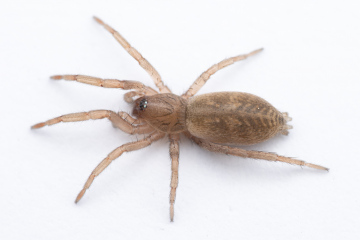Summary for Haplodrassus dalmatensis (Araneae)
previous species | next species
National Distribution
Terms of Use. Double-click on map to go to region

Explore Regional Distribution
Please log on and add a note on this species
About this species
Recorded altitude range0m to 160m
Species text
DistributionThe species is almost confined to southern heathlands and east coast dunes. It has also been found in Anglesey, and there are old records from Staffordshire (doubtful?) and Norfolk. It is widespread in western and central Europe as far north as Sweden, but is not recorded from Ireland.
Habitat and ecology
The spider occurs mainly on dry heathland at ground level among heather and under stones, but also sometimes on stable sand dunes or shingle on the coast. It appears on burnt heathland during the first year after fire, but reaches maximum densities between about 6 to 12 years after fire, then declines. Adult males are found between March and July, with a peak of activity in May and June, females from April to late August, with a peak of activity in June.
Status
UK Biodiversity Action Plan priority species. Although found to be widespread on heathland in Dorset, Hampshire, West Sussex and Surrey between 1965 and 1977, the species appears to have suffered a major decline, with nearly all modern records being coastal. There is a need for re-survey of southern heathland sites.
Threats
Threats include the loss of heathland to agriculture, afforestation and development and possibly public pressure on a few of its coastal sites.
Management and conservation
The spider is able to survive in all ages of heather except possibly in very old heather. Ensure regular management of heathland by grazing, rotational cutting or burning, to provide a range of different ages of heather.
Text based on Dawson, I.K., Harvey, P.R., Merrett, P. & Russell-Smith, A.R. (in prep.). References
Adult Season
Habitats
background methodology
Recorded management for locations with Haplodrassus dalmatensis
Recorded substrate and hydrology for locations with Haplodrassus dalmatensis
Images
please log on and upload a new image for this speciesSee also A-Z Species Index - A-Z Picture Index - previous species | next species
